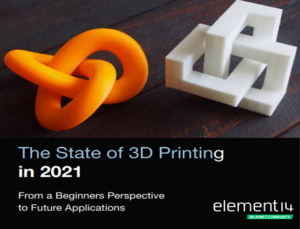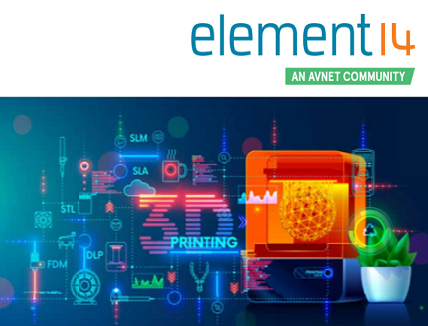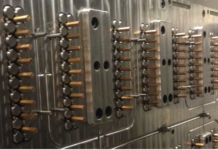
‘The state of 3D printing 2021’, discusses the origins of 3D printing, how it works, its future, and much more
element14 has released a new eBook that offers insights into the history and the reality of 3D printing, including the processes, materials, and applications — as well as what the future holds of this advancing technology.
The 3D printing industry has been developing rapidly over the past two decades, and has moved beyond large corporations and industry-only tools to affordable models that can now be found in garages and home labs. As with any other technology, companies have taken advantage of innovations that have driven 3D printing into new areas and applications. There are 3D printers that produce different foods, including pizzas, and others that build entire houses using massive robotic printers. The technology can be utilized for nearly anything and taken anywhere. The new eBook explores how all that has been made possible, including:
· A brief history of 3D printing
· Methods used to produce prints: Fused Deposition Modeling (FDM), Stereolithography (SLA) and Selective Laser Melting (SLM)
· Slicing software and how it works, including CAD software such as Blender and AutoCAD as well as open source slicers such as Prusa3D’s PrusaSlicer, which can let users fine-tune the 3D models and slice them into layers.
· Types of filaments used to make 3D models and their applications in various industries from food to aerospace: PLA, PEEK, PETG, ABS, resins, wood, cement and metals
· Current 3D printing technologies such as Stepcraft’s M-1000 series, Snap maker 2.0 , printers that make houses, tools for the space and medical devices
· How additive manufacturing is the future of 3D printing

Some of the best-selling printers from element14, an Avnet company, include:
· Multicomp MC-I20: A 3D printer that works right out of the box and is guaranteed to make great prints from day one, even in ABS. It has a 200mm x 200mm print bed, which is large enough for most things. What really sets this printer apart is the print quality. The MC-I20 has a layer height of 0.05 to 0.4mm, giving tight resolution that is achieved by modern print mechanics. It also has convenient features, like auto shutdown when the print is finished, and the ability to sense a broken filament line
· Ender – 3 V2: The Ender-3 V2 is an upgraded version of the popular Ender -3, featuring quick heat and ultra-quiet print modes, a more ridged all metal body, as well as a new carborundum glass platform for better bed performance. The printer can also resume printing after a power cut by detecting its position in the g code and continuing where it left off
· Epsilon W27: The Epsilon W27 is a powerful professional 3D printing solution, designed to deliver solid parts with industrial-grade materials. It features a passive heated chamber, full enclosure, and humidity controlled environment. It offers improved print quality in ABS, which is susceptible to warping. The 5” full colour, capacitive touchscreen ensures ease of use and control. Printing is available via Wi-Fi or Ethernet connectivity (online) or an SD Card (offline).
For more information on 3D printing, please check out our resources here. And to read the full eBook, please visit element14.com.


















